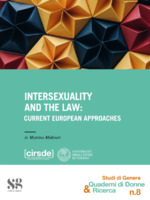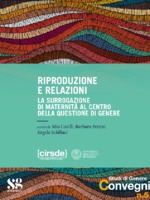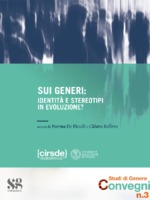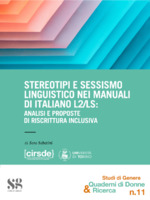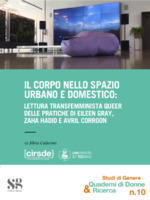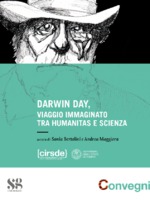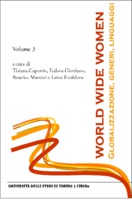Sfoglia documenti (27 in totale)
- Collezione: CIRSDe
Sort by:
Intersexuality and the Law: Current European Approaches
This essay focuses on the complex relationship between intersexuality and the law. It aims to highlight the issues that are emerging in European legal systems due to the lack of specific measures or legislation regarding gender identity, and the ad hoc legislation which does exist but fails to distinguish transsexualism from intersexuality.
The most pressing issue that the law should tackle is the performance of unnecessary, irreversible, and invasive surgery on intersex children. Indeed, most of European Member States do not explicitly legally ban this practice.
First, international and European Union law is considered noting that they do not provide for any legally binding instrument for the protection and recognition of intersex human right. However, in recent years they have shown to be progressively responsive towards intersex individuals.
Then, three legislative models are identified and the national legal frameworks corresponding to them analysed. The first, adopted by Germany and Austria, is based on the introduction of a third sex. The second is contained in Belgian legislation, and establishes the self-determination principle, which permits the choice of a preferred gender on identity documents, without particular requirements being met. The third approach has been adopted only by Malta so far. It is characterised by multiple measures and, accordingly, it is more systemic and holistic. In fact, the Maltese legislation explicitly recognises the intersex condition, and it conceives sex as a spectrum, thus going beyond gender binarism. Moreover, it prohibits discrimination based on sex characteristics, establishes the self-determination principle, and it bans irreversible, unnecessary, and aesthetic surgery from being carried out on intersex people.
Lastly, theoretical analysis on the role the law should play in tackling intersex issues is presented. Alongside, some factual cases of human rights violations on intersex people a way forward is proposed, considering the most interesting proposals and insights from the intersex community.
Riproduzione e relazioni. La surrogazione di maternità al centro della questione di genere
Il volume raccoglie i contributi presentati al Convegno «Riproduzione e Relazioni. La surrogazione di maternità al centro della questione di genere», svoltosi a Torino il 25 maggio 2018 grazie all'iniziativa congiunta di GenIUS (Rivista di studi giuridici sull'orientamento sessuale e l'identità di genere) e del CIRSDe (Centro Interdisciplinare di Ricerche e Studi delle Donne e di Genere dell’Università di Torino).
L'iniziativa aveva preso le mosse dal comune intento di interpretare attraverso il diritto le molteplici relazioni intersoggettive che la surrogazione di maternità fa sorgere, nonché dalla scelta condivisa di prediligere l’approccio di genere nell'analisi di tali relazioni, al fine di disvelare la spesso taciuta e insuperabile asimmetria tra i sessi nella procreazione. L’adozione della prospettiva di genere nell'inquadramento giuridico dei rapporti che si instaurano tra genitori intenzionali, madre biologica e nascitura/o o tra questi e le diverse figure professionali che rendono possibile la gestazione per altri, è stata dunque intesa come fil rouge idoneo a legare l’analisi della relazione di gravidanza effettuata da studiose e studiosi secondo le proprie specificità disciplinari.
SUI GENERI: Identità e stereotipi in evoluzione?
Il presente volume riporta la quasi totalità dei contributi presentati al Convegno Tematico della Sezione di Psicologia Sociale dell’Associazione Italiana di Psicologia che ha avuto luogo a Torino, dal 21 al 22 settembre, presso i locali del Dipartimento di Psicologia.
L’iniziativa è nata a partire sostanzialmente da due motivazioni di base:
a) riprendere una riflessione originata all’interno di GDG. Il Gruppo di Studio sulle Disparità di Genere (GDG), nato nel 2008 in seno alla Sezione di Psicologia Sociale dell’AIP, è stato promotore in passato di alcuni Simposi interni ai Convegni Nazionali dell’AIP – Sezione di Psicologia Sociale, oltre che di altri appuntamenti nazionali su questi temi;
b) creare un’occasione di confronto interdisciplinare e interprofessionale. Il titolo delle due giornate, volutamente inteso al plurale «Sui Generi», richiama la complessità del tema: dal gap di genere alla costruzione dell’identità; dal pregiudizio sessuale al ruolo svolto dai media (vecchi e nuovi), solo per citare qui alcune riflessioni che sono state sviluppate nell’arco delle due giornate.
L’evento ha visto la presenza di una media di circa un centinaio di persone. Nel corso delle due giornate sono state presentate 19 comunicazioni di ricerca, 6 poster, due relazioni alla tavola rotonda, una testimonianza via video.
Il presente volume è testimonianza della ricchezza dei contributi presentati. Esso è diviso in cinque sezioni: «Stereotipi di genere»; «Stereotipi oltre il genere femminile»; «Vecchi e nuovi media: dalla pubblicità ai social network»; «Il genere nei vari contesti sociali» e «Il gap di genere nel mondo del lavoro».
Stereotipi e sessismo linguistico nei manuali di italiano L2/LS: analisi e proposte di riscrittura inclusiva
The work aims at a reconnaissance of the current teaching material used in classes of Italian as a foreign language, bearing in mind the perspective of gender inclusive language and gender stereotypes.
A detailed linguistic analysis of copiuous textbooks – which was carried out upholding the approach of Italian linguist Alma Sabatini - highlights how the female world is still shaped through a male-dominant point of view. As a matter of fact, linguistich inclusivity often fails to be achieved, falling the Italian language into the grammatical gender languages type. The purpose of the analysis present in Chapter 3 is to show how a gender sensitive linguistic approach can be obtained and integrated into foreing language teaching material of Italian language, catering to all six level of the CEFR (Common European Framework of Reference for Languages) through degendering and engendering strategies.
On the other hand, the ambition of shaping multicultural beings across the world calls for the analysis of the socio-cultural aspects representing Italy in the aforementioned textbooks. This analysis (Chapter 4) recognizes five areas in which gender stereotypes, regarding the female sphere, are strongly pervasive and fail to represent the actual nuaces of life and personal identity - childhood, labour, family care, housekeeping, and physical appearence.
Lastly, Chapter 5 argues the outcomes of both the linguistic and socio-culultural analysis, in view of a future improvement of such teaching materials.
Il corpo nello spazio urbano e domestico: lettura transfemminista queer delle pratiche di Eileen Gray, Zaha Hadid e Avril Corroon
This essay aims to carry out, through a queer transfeminist methodology, an analysis of the built environment and architectural spaces, with reference to the work of Eileen Gray, Zaha Hadid and Avril Corroon.
In the introduction, the key terms of the paper will be defined, including transfeminism and queer studies. In summary, transfeminism refers to an intersectional feminist methodology that, in its analysis, considers, in addition to sexism, several axes of oppression, such as racism, classism, ableism, sexual orientation - and embraces the struggles of trans people (Filo Sottile 2020). Queer studies, on the other hand, refers to the study of issues involving gender identity and sexual orientation, questioning both the naturalness of the binary division of gender into male and female, as well as that of sexual orientation (Arfini 2020), demonstrating how gender identities are constructed within a set of behaviours, actions, beliefs, and stereotypes that are repeated through a system called gender performativity (Butler 1999). Queer transfeminism has, among its aims, to unhinge a binary system of power through the intersection of feminist and sexual liberation issues with struggles that relate to classism, racism, and ableism, to create an alliance between all subjectivities different from the norm, to achieve social justice.
The first chapter of this paper questions the role of the body in space, examining various urban and architectural structures. The theme of the heterosexual and ableist matrix as prerequisites for understanding our built environment (Wajcman 1991), i.e., the space that bodies relate to, is explored, illustrating the concept of performativity of gender and deviance introduced by Judith Butler (Butler 1999). The theme of the body in architectural design is addressed (Bianchetti 2020), and we finally focus on the issues of housing rights and dispossession, as well as that of social and housing justice (Butler, Athaniasiou 2019).
The second chapter examines the language of gender, analysing language and its constructive and imaginary potential. The role of gendered language in architecture is also analysed, and proposals are shown that can go beyond the limits that our language imposes.
Furthermore, how the mass media have represented bodies in space is explored, and specifically, the photographic material of Le Corbusier's works (Colomina 1992, 1994) and that of Hugh Hefner's Playboy fashion house (Preciado 2020) are analysed.
In the third, fourth and fifth chapters, the work of three female artists is explored: the work of Eileen Gray is examined, looking in particular at E.1027, the house that the designer-architect realised in France, according to a queer reading of the architectural project; Zaha Hadid's practice is read from a transfeminist perspective, and in particular through Donna Haraway's cyborg myth; the work of Avril Corroon, a contemporary Irish visual artist, is analysed, whose practice questions the housing emergency in the contemporary neoliberal market.
Darwin Day, viaggio immaginato tra Humanitas e Scienza
Questo testo prende spunto da due eventi organizzati in occasione dell’International Darwin Day, l’appuntamento annuale che cade nel compleanno di Charles Darwin, il naturalista britannico nato il 12 febbraio 1809 che con la teoria dell’evoluzione ha cambiato la lettura degli eventi del mondo naturale, e che ha lo scopo di invitare le persone di tutto il mondo a riflettere e agire in base ai principi di coraggio intellettuale, curiosità scientifica e onestà di ricerca, incarnati nel pensiero di Charles Darwin.
Il 12 febbraio 2016 anche l’Istituto Musicale Città di Rivoli celebrava il Darwin Day con un evento musicale inserito nel cartellone della stagione concertistica Rivolimusica 2015/2016. Collegato con questo appuntamento il CIRSDe – Centro Interdisciplinare di Studi e Ricerche delle Donne e di Genere dell’Università di Torino – organizzava un convegno su C. Darwin: studiosi di fama internazionale sono stati chiamati a confrontarsi sull’impatto del pensiero dello studioso in diverse discipline, in particolare la filosofia, la scienza, la fisica, la sociologia, la medicina, la storia della musica.
Il successo dell’iniziativa ci ha indotto a ripetere il Darwin Day anche nel 2017 con l’intervento di Angelo Adamo, astrofisico/musicista/divulgatore e il suo Viaggio di un naturalista intorno… al Castello di Rivoli. La descrizione dell’esperienza effettuata sarà illustrata meglio nel suo contributo, presente in questo volume.
I saggi considerati in questo libro derivano da queste due esperienze. Nella loro eterogeneità di argomenti trattati, essi mostrano il forte impatto delle teorie darwiniane su svariati aspetti dalla fisica, alle teorie di genere, alla sfera musicale. Questo non deve stupire. È l’approccio di Darwin alla realtà che pone in discussione i tradizionali metodi di fare ricerca e osservare la realtà. Le sue teorie, se depurate da alcune concettualizzazioni che risentono del periodo storico in cui ha vissuto, sono delle vere e proprie metodologie di approccio all’analisi. E la loro potenza, mostrata attraverso questi saggi, fa comprendere come possano essere state oggetto di critiche e di rifiuto da parte di altri studiosi e teorici dell’epoca, ma anche di oggi.
World Wide Women: Globalizzazione, Generi, Linguaggi — Vol. 3
Questo è il terzo di una serie di 4 volumi che raccolgono una selezione degli atti del convegno internazionale «World Wide Women: Globalizzazione, Generi, Linguaggi», organizzato dal CIRSDe nel febbraio 2011 c/o l’Università di Torino. I/le ricercatori/trici si sono confrontati in una prospettiva gender oriented sulla globalizzazione, l’incontro di culture, il transculturalismo, il superamento dei confini nazionali, la migrazione, i linguaggi, lo sviluppo economico.
Questo terzo volume affronta più nel dettaglio le seguenti tematiche: le migrazioni in relazione al lavoro di cura; le scritture migranti nel Nord America e in Italia.

